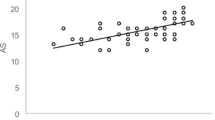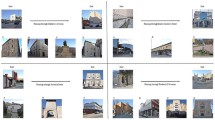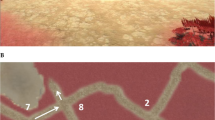Abstract
People orient themselves in the environment using three different, hierarchically organized, spatial cognitive styles: landmark, route, and survey. Landmark style is based on a representation encompassing only visual information (terrain features); route style is based on a representation that connects landmarks and routes using an egocentric (body-centred) frame of reference; survey style is based on a global map-like representation that mainly involves an allocentric (world-centred) frame of reference. This study was aimed at investigating whether individual spatial cognitive style affected the way to plan a path when searching for a lost object. Participants with landmark, route, and survey style were assessed with an ecological navigational planning task (the Key Search Task), which required planning a strategy to search for the lost key in a hypothetical wide squared field. Results showed that spatial cognitive styles were associated to different navigational planning strategies, although the time to complete the Key Search Task was comparable across the styles. As revealed by the Key Search Task score, survey style individuals were the best navigational planners, route style individuals were less efficient and landmark style individuals were the least efficient. These results suggest that spatial cognitive style has effects on navigational planning. Implications for clinical settings, such as for developmental topographical disorientation, are discussed.




Similar content being viewed by others
References
Arleo A, Rondi-Reig L (2007) Multimodal sensory integration and concurrent navigation strategies for spatial cognition in real and artificial organisms. J Integr Neurosci 6:327–366
Barbaranelli C, D’Olimpio F (2006) Analisi dei dati con SPSS, vol 2. Led, Milano
Bianchini F, Incoccia C, Palermo L, Piccardi L, Zompanti L, Sabatini U, Peran P, Guariglia C (2010) Developmental topographical disorientation in a healthy subject. Neuropsychologia 48:1563–1573
Bianchini F, Palermo L, Piccardi L, Incoccia C, Nemmi F, Sabatini U, Guariglia C (2014) Where am I? A new case of developmental topographical disorientation. J Neuropsychol 8:107–124
Bocchi A, Carrieri M, Lancia S, Quaresima V, Piccardi L (2017) The Key of the Maze: the role of mental imagery and cognitive flexibility in navigational planning. Neurosci Lett 651:146–150
Bocchi A, Giancola M, Piccardi L, Palmiero M, Nori R, D’Amico S (2018) How would you describe a familiar route or put in order the landmarks along it? It depends on your cognitive style! Exp. Brain Res 2018:3121–3129
Boccia M, Nemmi F, Guariglia C (2014) Neuropsychology of environmental navigation in humans: review and meta-analysis of FMRI studies in healthy participants. Neuropsychol Rev 24:236–251
Boccia M, Silveri MC, Sabatini U, Guariglia C, Nemmi F (2016) Neural underpinnings of the decline of topographical memory in mild cognitive impairment. Am J Alzheimers Dis Other Demen 31:618–630
Boccia M, Piccardi L, D’Alessandro A, Nori R, Guariglia C (2017a) Restructuring the navigational field: individual predisposition towards field independence predicts preferred navigational strategy. Exp Brain Res 235:1741–1748
Boccia M, Vecchione F, Piccardi L, Guariglia C (2017b) Effect of cognitive style on learning and retrieval of navigational environment. Front Pharmacol 8:1–10
Boccia M, Di Vita A, Diana S, Margiotta R, Imbriano L, Rendace L, Campanelli A, D’Antonio F, Trebbastoni A, De Lena C, Piccardi L, Guariglia C (2019) Is losing ones’ way a sign of cognitive decay? Topographical memory deficit as an early marker of pathological ageing. J Alzheimers Dis
Byrne P, Becker S, Burgess N (2007) Remembering the past and imagining the future: a neural model of spatial memory and imagery. Psychol Rev 114:340–375
Carrieri M, Lancia S, Bocchi A, Ferrari M, Piccardi L, Quaresima V (2018) Does ventrolateral prefrontal cortex help in searching for the lost key? Evidence from an fNIRS study. Brain Imaging Behav 12:785–797
Dahmani L, Bohbot VD (2015) Dissociable contributions of the prefrontal cortex to hippocampus-and caudate nucleus-dependent virtual navigation strategies. Neurobiol Learn Mem 117:42–50
Gärling T, Böök A, Lindberg E (1984) A cognitive mapping of large-scale environments: the interrelationships of action plans, acquisition of orientation. Environ Behav 16:3–34
Gärling T, Böök A, Lindeberg E (1986) Spatial orientation and way-finding in the designed environment. A conceptual analysis and some suggestions for postoccupancy evaluation. J Arch Plan Res 3:55–64
Hayes-Roth B, Hayes-Roth F (1979) A cognitive model of planning. Cogn Sci 3:275–310
Howard LR, Javadi AH, Yu Y, Mill RD, Morrison LC, Knight R, Spiers HJ (2014) The hippocampus and entorhinal cortex encode the path and Euclidean distances to goals during navigation. Curr Biol 24:1331–1340
Iaria G, Barton JJ (2010) Developmental topographical disorientation: a newly discovered cognitive disorder. Exp Brain Res 206:189–196
Iaria G, Bogod N, Fox CJ, Barton JJS (2009) Developmental topographical disorientation: case one. Neuropsychologia 47:30–40
Kirasic KC (1991) Spatial cognition and behavior in young and elderly adults: implications for learning new environments. Psychol Aging 6:10–18
Kitchin RM (1994) Cognitive maps: what are they and why study them? J Environ Psychol 14:1–19
Kozhevnikov M (2007) Cognitive styles in the context of modern psychology: toward an integrated framework of cognitive style. Psychol Bull 133:464–481
Kraemer DJ, Rosenberg LM, Thompson-Schill SL (2009) The neural correlates of visual and verbal cognitive styles. J Neurosci 29:3792–3798
Martinet LE, Sheynikhovich D, Benchenane K, Arleo A (2011) Spatial learning and action planning in a prefrontal cortical network model. PLoS Comput Biol 7(5):e1002045
Mullally SL, Maguire EA (2014) Memory, imagination, and predicting the future: a common brain mechanism? Neuroscientist 20:220–234
Nemmi F, Bianchini F, Piras F, Péran P, Palermo L, Piccardi L et al (2015) Finding my own way: an fMRI single case study of a subject with developmental topographical disorientation. Neurocase 21:573–583
Nori R, Giusberti F (2003) Cognitive styles: errors in directional judgments. Perception 32:307–320
Nori R, Giusberti F (2006) Predicting cognitive styles from spatial abilities. Am J Psychol 119:67–86
Nori R, Piccardi L (2011) Familiarity and spatial cognitive style: how important are they for spatial representation. In: Spatial memory: visuospatial processes, cognitive performance and developmental effects, pp 123–144
Nori R, Grandicelli S, Giusberti F (2006) Alignment effect: primary–secondary learning and cognitive styles. Perception 35:1233–1249
Nori R, Grandicelli S, Giusberti F (2009) Individual differences in visuo-spatial working memory and real-world wayfinding. Swiss J Psychol 68:7
Nori R, Piccardi L, Palermo L, Guariglia C, Giusberti F (2012) Working memory load elicits gender differences in mental imagery. In: McGeown SP (ed) Psychology of gender differences. Nova Science Publishers Inc., New York, pp 161–173
Paivio A, Harshman R (1983) Factor analysis of a questionnaire on imagery and verbal habits and skills. Can J Exp Psychol 37:461–483
Palermo L, Foti F, Ferlazzo F, Guariglia C, Petrosini L (2014a) I find my way in a maze but not in my own territory! Navigational processing in developmental topographical disorientation. Neuropsychology 28:135–146
Palermo L, Piccardi L, Bianchini F, Nemmi F, Giorgio V, Incoccia C et al (2014b) Looking for the compass in a case of developmental topographical disorientation: a behavioural and neuroimaging study. J Clin Exp Neuropsychol 36:464–481
Palmiero M, Piccardi L (2017) The role of emotional landmarks on topographical memory. Front Psychol 8:763
Pazzaglia F, De Beni R (2006) Are people with high and low mental rotation abilities differently susceptible to the alignment effect? Perception 35:369–383
Pazzaglia F, Cornoldi C, De Beni R (2000) Differenze individuali nella rappresentazione dello spazio: presentazione di un questionario autovalutativo [Individual differences in spatial representation and in orientation ability: presentation of a self-report questionnaire]. G Ital Psicol 3:627–650
Pazzaglia F, Meneghetti C, Ronconi L (2018) Tracing a route and finding a shortcut: the working memory, motivational, and personality factors involved. Front Hum Neurosci 12:225. https://doi.org/10.3389/fnhum.2018.00225
Piccardi L, Nori R, Palermo L, Guariglia C, Giusberti F (2015) Age effect in generating mental images of buildings but not common objects. Neurosci Lett 602:79–83
Piccardi L, De Luca M, Nori R, Palermo L, Iachini F, Guariglia C (2016) Navigational style influences eye movement pattern during exploration and learning of an environmental map. Front Behav Neurosci 10:140
Piccardi L, Bocchi A, Palmiero M, Verde P, Nori R (2017) Mental imagery skills predict the ability in performing environmental directional judgements. Exp Brain Res 235:2225–2233
Piccardi L, Palmiero M, Bocchi A, Boccia M, Guariglia C (2019a) How does environmental knowledge allow us to come back home? Exp Brain Res 1-10. https://doi.org/10.1007/s00221-019-05552-9
Piccardi L, De Luca M, Di Vita A, Palermo L, Tanzilli A, Dacquino C, Pizzamiglio MR (2019b) Evidence of taxonomy for developmental topographical disorientation: developmental landmark agnosia case 1. Appl Neuropsychol Child 2017:1–12
Schacter DL, Benoit RG, Szpunar KK (2017) Episodic future thinking: mechanisms and functions. Curr Opin Behav Sci 17:41–50
Sholl MJ, Nolin TL (1997) Orientation specificity in representations of place. J Exp Psychol Learn Mem Cogn 23:1494
Siegel W, White SH (1975) The development of spatial representations of large-scale environments. In: Reese HW (ed) Advances in child development, vol 10. Academic Press, New York, pp 9–55
Spiers HJ, Gilbert SJ (2015) Solving the detour problem in navigation: a model of prefrontal and hippocampal interactions. Front Hum Neurosci 9:125
Suchman L (1987) Plans and situated actions: the problem of human–machine communication. Cambridge University Press, Cambridge
Tascón L, Boccia M, Piccardi L, Cimadevilla JM (2017) Differences in spatial memory recognition due to cognitive style. Front Pharmacol 8:1–7
Tulving E (1972) Episodic and semantic memory. Organ Mem 1:381–403
Verde P, Angelino G, Piccolo F, Carrozzo P, Bottiglieri A, Lugli L, Piccardi L, Nori R (2018) Spatial orientation and directional judgments in pilots vs. nonpilots. Aerosp Med Hum Perform 89:857–862
Warren DH, Scott TE (1993) Map alignment in traveling multisegment routes. Environ Behav 25:643–666
Wiener JM, Ehbauer NN, Mallot HA (2009) Planning paths to multiple targets: memory involvement and planning heuristics in spatial problem solving. Psychol Res PRPF 73:644
Wilkniss SM, Jones MG, Korol DL, Gold PE, Manning CA (1997) Age-related differences in an ecologically based study of route learning. Psychol Aging 12:372–375
Willcutt EG, Doyle AE, Nigg JT, Faraone SV, Pennington BF (2005) Validity of the executive function theory of attention-deficit/hyperactivity disorder: a meta-analytic review. Biol Psychiatry 57:1336–1346
Wilson BA, Alderman N, Burgess PW, Emslie HC, Evans JJ (1996) The behavioural assessment of the dysexecutive syndrome. Cambridge University Press, New York
Wolbers T, Hegarty M (2010) What determines our navigational abilities? Trends Cogn Sci 14:138–146
Funding
None.
Author information
Authors and Affiliations
Corresponding author
Ethics declarations
Conflict of interest
The authors declare that they have no conflicts of interest.
Ethical approval
All procedures performed in studies involving human participants were in accordance with the ethical standards of the institutional and/or national research committee and with the 1964 declaration of Helsinki and its later amendments, or with comparable ethical standards.
Additional information
Publisher's Note
Springer Nature remains neutral with regard to jurisdictional claims in published maps and institutional affiliations.
Rights and permissions
About this article
Cite this article
Bocchi, A., Palmiero, M., Nori, R. et al. Does spatial cognitive style affect how navigational strategy is planned?. Exp Brain Res 237, 2523–2533 (2019). https://doi.org/10.1007/s00221-019-05609-9
Received:
Accepted:
Published:
Issue Date:
DOI: https://doi.org/10.1007/s00221-019-05609-9




